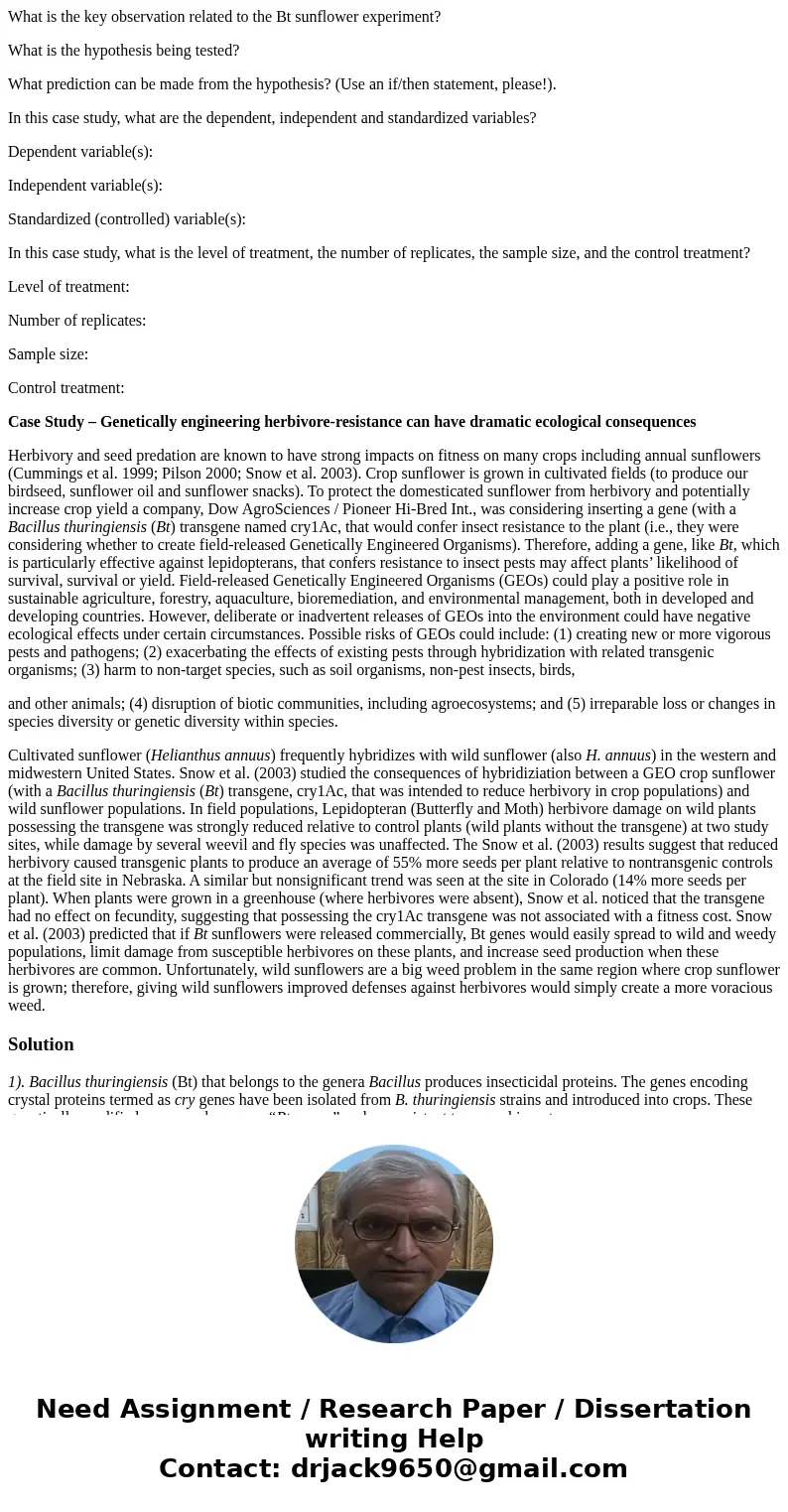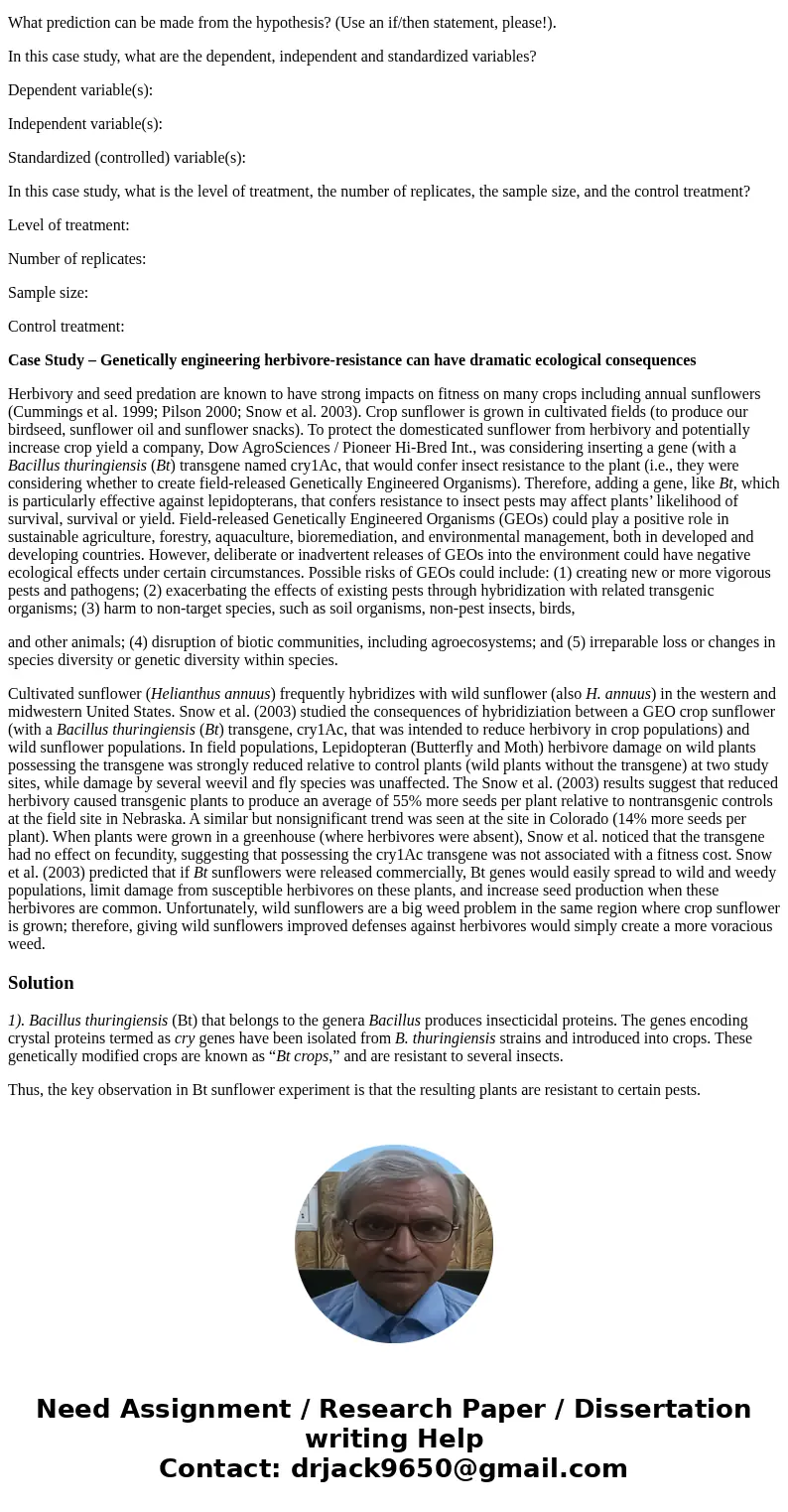What is the key observation related to the Bt sunflower expe
What is the key observation related to the Bt sunflower experiment?
What is the hypothesis being tested?
What prediction can be made from the hypothesis? (Use an if/then statement, please!).
In this case study, what are the dependent, independent and standardized variables?
Dependent variable(s):
Independent variable(s):
Standardized (controlled) variable(s):
In this case study, what is the level of treatment, the number of replicates, the sample size, and the control treatment?
Level of treatment:
Number of replicates:
Sample size:
Control treatment:
Case Study – Genetically engineering herbivore-resistance can have dramatic ecological consequences
Herbivory and seed predation are known to have strong impacts on fitness on many crops including annual sunflowers (Cummings et al. 1999; Pilson 2000; Snow et al. 2003). Crop sunflower is grown in cultivated fields (to produce our birdseed, sunflower oil and sunflower snacks). To protect the domesticated sunflower from herbivory and potentially increase crop yield a company, Dow AgroSciences / Pioneer Hi-Bred Int., was considering inserting a gene (with a Bacillus thuringiensis (Bt) transgene named cry1Ac, that would confer insect resistance to the plant (i.e., they were considering whether to create field-released Genetically Engineered Organisms). Therefore, adding a gene, like Bt, which is particularly effective against lepidopterans, that confers resistance to insect pests may affect plants’ likelihood of survival, survival or yield. Field-released Genetically Engineered Organisms (GEOs) could play a positive role in sustainable agriculture, forestry, aquaculture, bioremediation, and environmental management, both in developed and developing countries. However, deliberate or inadvertent releases of GEOs into the environment could have negative ecological effects under certain circumstances. Possible risks of GEOs could include: (1) creating new or more vigorous pests and pathogens; (2) exacerbating the effects of existing pests through hybridization with related transgenic organisms; (3) harm to non-target species, such as soil organisms, non-pest insects, birds,
and other animals; (4) disruption of biotic communities, including agroecosystems; and (5) irreparable loss or changes in species diversity or genetic diversity within species.
Cultivated sunflower (Helianthus annuus) frequently hybridizes with wild sunflower (also H. annuus) in the western and midwestern United States. Snow et al. (2003) studied the consequences of hybridiziation between a GEO crop sunflower (with a Bacillus thuringiensis (Bt) transgene, cry1Ac, that was intended to reduce herbivory in crop populations) and wild sunflower populations. In field populations, Lepidopteran (Butterfly and Moth) herbivore damage on wild plants possessing the transgene was strongly reduced relative to control plants (wild plants without the transgene) at two study sites, while damage by several weevil and fly species was unaffected. The Snow et al. (2003) results suggest that reduced herbivory caused transgenic plants to produce an average of 55% more seeds per plant relative to nontransgenic controls at the field site in Nebraska. A similar but nonsignificant trend was seen at the site in Colorado (14% more seeds per plant). When plants were grown in a greenhouse (where herbivores were absent), Snow et al. noticed that the transgene had no effect on fecundity, suggesting that possessing the cry1Ac transgene was not associated with a fitness cost. Snow et al. (2003) predicted that if Bt sunflowers were released commercially, Bt genes would easily spread to wild and weedy populations, limit damage from susceptible herbivores on these plants, and increase seed production when these herbivores are common. Unfortunately, wild sunflowers are a big weed problem in the same region where crop sunflower is grown; therefore, giving wild sunflowers improved defenses against herbivores would simply create a more voracious weed.
Solution
1). Bacillus thuringiensis (Bt) that belongs to the genera Bacillus produces insecticidal proteins. The genes encoding crystal proteins termed as cry genes have been isolated from B. thuringiensis strains and introduced into crops. These genetically modified crops are known as “Bt crops,” and are resistant to several insects.
Thus, the key observation in Bt sunflower experiment is that the resulting plants are resistant to certain pests.


 Homework Sourse
Homework Sourse